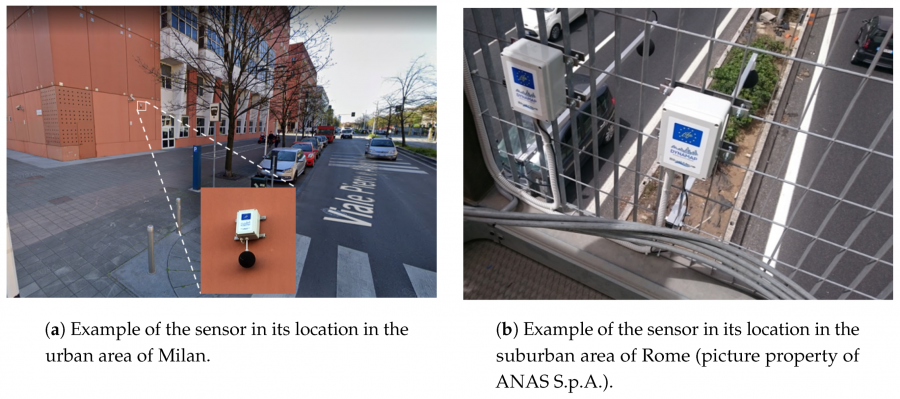AGGREGATE IMPACT OF ANOMALOUS NOISE EVENTS ON THE WASN-BASED COMPUTATION OF ROAD TRAFFIC NOISE LEVELS IN URBAN AND SUBURBAN ENVIRONMENTS

Environmental noise can be defined as the accumulation of noise pollution caused by sounds generated by human activity outdoors. According to the World Health Organization (WHO), noise exposure produces a loss of around one million healthy life years in Western Europe every year. In urban and suburban areas, these dramatic effects of environmental noise pollution are mainly caused by Road Traffic Noise (RTN). Recently, Wireless Acoustic Sensor Networks (WASNs) have become an alternative for the creation of the noise maps required by the European Noise Directive (END), since they allow the ubiquitous monitoring of environmental noise levels. Among them, the European LIFE DYNAMAP project, aims at developing a WASN-based dynamic noise mapping system to monitor the acoustic impact of road infrastructures through the creation of noise maps in real time. The project includes two pilot areas: one in the District 9 of Milan as urban area, and another in the A90 highway surrounding Rome as a suburban area. As the system focuses on measuring RTN levels solely, the noise monitoring pipeline should automatically remove those acoustic events non-related to traffic noise, denoted as Anomalous Noise Events (ANEs).

Researchers from the signal processing area of the GTM, Prof. Francesc Alías, Ferran Orga, Dr. Rosa Ma Alsina-Pagès and Dr. Joan Claudi Socoró have evaluated the impact of ANEs on the computation of the A-weighted equivalent RTN levels in an aggregate manner from acoustic data gathered from real-operation. The study has been conducted on 304h and 20 min of WASN-based labeled acoustic data collected through both sensor networks, after their deployment in both pilot areas, introducing an impact analysis methodology that allows computing the individual and aggregate impacts of ANEs for each sensor location and impact range (low, medium and high) for a given integration time.
Besides confirming the regular occurrence of ANEs in real-life acoustic environments, especially common in the Milan urban are, the results show that the aggregate contribution of low- and medium-impact (e.g., continuous works in the street) ANEs can become as critical as the presence of high-impact individual ANEs (e.g., a siren, thunder, etc.) when trying to monitor RTN levels solely through a WASN.
More details can be found in the following Open Access paper:
Francesc Alías, Ferran Orga, Rosa Ma. Alsina-Pagès, Joan Claudi Socoró (2020); "Aggregate Impact of Anomalous Noise Events on the WASN-Based Computation of Road Traffic Noise Levels in Urban and Suburban Environments", Sensors Sensors (Special Issue "Smart Wireless Acoustic Sensor Network Design for Noise Monitoring in Smart Cities") (MDPI), 20(3), 609, https://doi.org/10.3390/s20030609
with abstract:
Environmental noise can be defined as the accumulation of noise pollution caused by sounds generated by outdoor human activities, Road Traffic Noise (RTN) being the main source in urban and suburban areas. To address the negative effects of environmental noise on public health, the European Environmental Noise Directive requires EU member states to tailor noise maps and define the corresponding action plans every five years for major agglomerations and key infrastructures. Noise maps have been hitherto created from expert-based measurements, after cleaning the recorded acoustic data of undesired acoustic events, or Anomalous Noise Events (ANEs). In recent years, Wireless Acoustic Sensor Networks (WASNs) have become an alternative. However, most of the proposals focus on measuring global noise levels without taking into account the presence of ANEs. The LIFE DYNAMAP project has developed a WASN-based dynamic noise mapping system to analyze the acoustic impact of road infrastructures in real time based solely on RTN levels. After studying the bias caused by individual ANEs on the computation of the A-weighted equivalent noise levels through an expert-based dataset obtained before installing the sensor networks, this work evaluates the aggregate impact of the ANEs on the RTN measurements in a real-operation environment. To that effect, 304 h and 20 min of labeled acoustic data collected through the two WASNs deployed in both pilot areas have been analyzed, computing the individual and aggregate impacts of ANEs for each sensor location and impact range (low, medium and high) for a 5 min integration time. The study shows the regular occurrence of ANEs when monitoring RTN levels in both acoustic environments, which are especially common in the urban area. Moreover, the results reveal that the aggregate contribution of low- and medium-impact ANEs can become as critical as the presence of high-impact individual ANEs, thus highlighting the importance of their automatic removal to obtain reliable WASN-based RTN maps in real-operation environments.
Acknowledgements:
The authors would like to thank ANAS S.p.A. for the picture of the sensor installed in the portal. The research presented in this work has been partially supported by the LIFE DYNAMAP project (LIFE13 ENV/IT/001254). Joan Claudi Socoró thanks the Obra Social La Caixa for grant ref. 2019-URL-IR1rQ-053. Ferran Orga thanks the support of the European Social Fund and the Secretaria d’Universitats i Recerca del Departament d’Economia i Coneixement of the Catalan Government for the pre-doctoral FI grant No. 2019_FI_B2_00168.